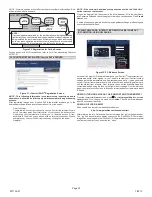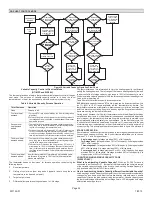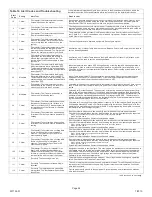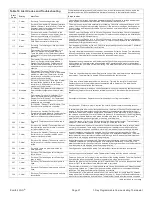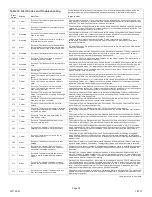
507152-01
7/2013
Page 26
Table 10. Alert Codes and Troubleshooting
Critical alerts are displayed on Home (user) screen, in the Homeowner alert button, and in the
Installer alert button. Minor and Moderate alerts are found only in the Installer alert button.
Alert
Code
Priority
Alert Text
Steps to clear
10
Critical
(Thermostat) The thermostat has found an
unknown device on the system.
An unknown device is seen on the sub-net in or outside of configuration mode. Clear by recon
figuring the system. Press the setup tab, press start, and press confirm. If problem persists,
then check all DEVICE connections to make sure they are iComfort-compatible.
11
Critical
(Thermostat) The thermostat cannot find a
previously installed unit.
Check all connections and cycle system power. If problem persists, clear by reconfiguring the
system. Press the setup tab, press start, and press confirm. If problem persists, then check all
DEVICE connections to make sure they are iComfort-compatible.
12
Critical
(Thermostat) The thermostat cannot find an
iComfort-enabled indoor unit.
Thermostat did not find an Indoor Unit. Make sure there is an iComfort indoor unit on the sys
tem. Check R, i+, i- and C connections, ohm wires and cycle power. Replace indoor unit control
board if there is no response.
14
Critical
(Thermostat) The thermostat found more
than one thermostat, more than one indoor
unit, or more than one outdoor unit on the
system.
Check wiring and remove duplicate equipment. Reconfigure system.
18
Minor
(Thermostat) The outside temperature is be
low the level where the heat pump is pro
grammed to heat the home. The system will
not use the heat pump to warm your home.
Notification only - Outdoor Temp is below the Low Balance Point. Heat Pump will not be used to
service a heating demand.
19
Minor
(Thermostat) The outside temperature is
higher than the level where the furnace or
electric heat is programmed to work. The
system will only use the heat pump to warm
your home.
Notification only - Outdoor Temp is above the High Balance Point. Indoor Unit (furnace or air-
handler) will not be used to service a heating demand.
29
Critical
(Thermostat) The thermostat is reading an
indoor temperature that is higher than 99ºF.
The thermostat will not allow any heating op
eration to begin until it senses a temperature
lower than 99ºF.
Indoor temperature rose above 99ºF during a heating or cooling demand. Heating operation is
not allowed. Check to ensure that Heating Equipment is not stuck ON (reversing valve, etc.).
Check the accuracy of the thermostat temperature sensor. Select cooling system mode to cool
the indoor space.
30
Moderate
(Thermostat) The thermostat is reading an
indoor temperature that is lower than 40ºF.
The thermostat will not allow any cooling op
eration to begin until it senses a temperature
higher than 40ºF.
Indoor Temp fell below 40ºF. Cooling operation is not allowed. Check to ensure that cooling
equipment is not stuck ON. Check accuracy of the thermostat temperature sensor. Select
heating system mode to heat the indoor space to above 40ºF.
31
Critical
(Thermostat) The thermostat has lost com
munication with the
(furnace, air-handler or
outdoor unit)
for more than 3 minutes.
[
Indicated unit
] has not communicated with thermostat for more than 3 minutes. Check connec
tions. Ohm wires. If fault persists, then cycle power. Fault clears after communication is re
stored.
32
Moderate
(Thermostat) The
(furnace, air-handler or
outdoor unit)
is resetting itself.
[
Indicated unit
] is resetting itself. This event may occur during a power outage or power fluctu
ation in the system. If persistent or if it coincides with the system operation then proceed with
the following steps. Check the power connections, check the amp draw at the transformer (the
transformer maybe overloaded) and check 24VAC voltage at the DEVICE. The alarm is only
cleared by pressing the clear button on the Installer Alerts Tab. If the fault persists after check
ing the connections, replace the unit's control board.
34
Critical
(Thermostat) The thermostat does not know
the capacity (tonnage) of the
(furnace, air-
handler or outdoor unit)
. Please program the
correct capacity of the
(furnace, air-handler
or outdoor unit).
[
Indicated unit
] is missing the programmed unit capacity. Go to [
Indicated unit
] and program the
unit capacity manually. See the unit IOM for programming instructions. Remove power to ther
mostat before programming the unit control board. Once programming is complete, reconnect
thermostat wires and reconfigure system.
36
Critical
(Thermostat) The system has been heating
for at least 15 minutes, without a demand for
heating.
Run the system in diagnostic mode and verify that it matches actual equipment operation.
Check for other alarms/codes that may be preventing the system from operating as expected.
Step 1: Check all heating equipment to determine cause of heating demand.
Step 2: Recycle power.
System will clear code when it detects condition has cleared.
37
Critical
(Thermostat) The system has been cooling
for at least 15 minutes, without a demand for
cooling.
Run the system in diagnostic mode and verify that it matches actual equipment operation.
Check for other alarms/codes that may be preventing the system from operating as expected.
Step 1: Check all cooling equipment to determine cause of cooling demand.
Step 2: Recycle power.
System will clear code when it detects condition has cleared.
38
Critical
(Thermostat) The system has not been able
to turn on the heating for more than 45
minutes. The system will go offline for 60
minutes and try again.
Run the system in diagnostic mode and verify that it matches actual equipment operation.
Check for other alarms/codes that may be preventing the system from operating as expected.
Step 1: Check all heating equipment to determine cause.
Step 2: Recycle power.
System will clear code when it detects condition has cleared.
39
Critical
(Thermostat) The system has not been able
to turn on the cooling for more than 45
minutes. The system will go offline for 60
minutes and try again.
Run the system in diagnostic mode and verify that it matches actual equipment operation.
Check for other alarms/codes that may be preventing the system from operating as expected.
Step 1: Check all cooling equipment to determine cause.
Step 2: Recycle power.
System will clear code when it detects condition has cleared.
105
Critical
(Thermostat / Furnace / Air Handler / Out
door Unit/ Equpment Interface Module /
Damper Control Module) The
(Thermostat,
furnace, air-handler or outdoor unit)
has lost
communication with the rest of the system.
Equipment is unable to communicate. This may indicate the existence of other alarms/codes. In
most cases errors are related to electrical noise. Make sure high voltage power is separated
from RSBus. Check for incorrectly wired and/or loose connections between the Thermostat,
indoor unit and outdoor unit. Check for a high voltage source of noise close to the system.
Generally, this is a self-recoverable error.
110
Critical
(Furnace) The line voltage is too low.
This alarm/code may appear during a brownout. Line voltage is below its designed operating
value. Check and correct the power line voltage.
111
Critical
(Furnace) The line power voltage wiring is
reversed.
The unit is reporting that its power line and neutral are reversed. Turn off the power to the sys
tem and correct the line power voltage wiring. System resumes normal operation 5 seconds
after fault recovered.
112
Critical
(Furnace) The reporting device cannot find
earth ground. The thermostat will shut down
the system.
Provide proper earth ground to the equipment. System resumes normal operation 5 seconds
after fault recovered.
table continued on next page









